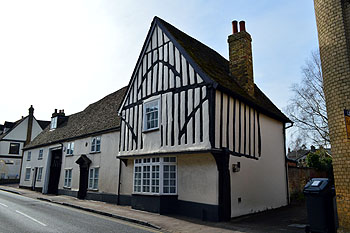4 Sun Street Potton

4 Sun Street February 2013
4 Sun Street was listed by the former Ministry of Works in January 1952 as Grade II, of special interest. The building is timber-framed and is covered in colourwashed render. The roofs are composed of clay tiles. The property comprises two storeys. There is a cross-wing at the right hand side and a projecting gable at the rear.
The property was the Sun Inn, after which the street is named, the earliest definite mention of which is probably in 1668 Andrew Rayment was presented at the assizes for having a common ale house in Potton contrary to statute [HSA1668W]. This may well be the Sun as it is known that it was in the ownership of the Rayment family later in the century [PE410-415]. The inn closed for the last time on 21st December 1907. The Sun then became a private house.
The Rating and Valuation Act 1925 specified that every building and piece of land in the country was to be assessed to determine its rateable value. The valuer visiting 4 and 6 Sun Street found the properties owned by William Tear. The former inn [DV1/C11/86] comprised three reception rooms, a lumber room and pantry, a cellar and a scullery with four bedrooms and a bathroom above.
Behind Number 6 was a long range of outbuildings [DV1/C11/85] occupied, like Number 4, by William Tear himself who is listed in Kelly’s Directory for Bedfordshire of 1928 as a market gardener. There was a brick and slate range comprising a barn, a seven stall stable and garage and a three stall stable used as a store, all with a loft over. There was also a wood and corrugated iron three bay hovel, a wood and corrugated iron open barn and hovel and a brick and tiled garage with a petrol engine carrot washer and a gas engine, there was also a four stall stable used as a barn and all had a loft over it and a scullery. The yard was partly covered in corrugated iron and wood.
William Tear is listed in the last Kelly’s Directory for the county in 1940. At a later date the premises became W. Kitchener and Sons. Their billhead describes them as pictorial sign artists, plumbers and decorators [X704/92/42]. A detailed description of the building can be found in Bedfordshire Archaeological Journal volume 14, pages 77 to 86. This notes that the adjoining 6 Sun Street has "no obvious structural relationship" to the former inn.